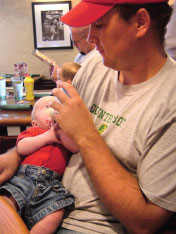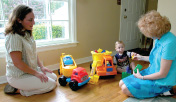Working Across Cultures to Nurture Healthy Babies
- Mildred A. Horodynski
- Professor
- College of Nursing
For the past 15 years, Mildred Horodynski has directed her research toward helping low-income mothers of infants and toddlers develop healthy feeding behaviors. The goal is to reduce the risk of childhood obesity, which has been identified as a critical public health threat by the Institute of Medicine.[1] NIH has set as one of its priorities improving the health status of racial and ethnic minorities in the U.S. In Michigan, 30.5 percent of low-income children aged 2-5 and enrolled in WIC are overweight or obese.[2]

Introducing the right solid foods at the right time and in the right amounts is important for later health.
"The first year of life is a critical period for reducing risk of obesity, particularly the first six months," said Horodynski, who is currently the principal investigator on a $1.5 million federally-funded grant from the USDA, "Healthy Babies Through Infant Centered Feeding." Research partners from Colorado State University (CSU) Department of Food Science and Human Nutrition and CSU Extension, along with MSU colleagues from Food Science and Human Nutrition, Human Development and Family Studies, University Outreach and Engagement, and MSU Extension, are testing a skill-building and educational intervention aimed at helping mothers to understand their baby's feeding style and to be sensitive to the baby's cues.

Dads help keep babies healthy too.
"What we're concerned about, especially with bottle-fed babies, is not just weight gain, but rapid weight gain, in the first couple months of life," explained Horodynski, "because rapid weight can set up a pattern that leads to childhood overweight and obesity later in life."
The intervention is an evidence-based curriculum developed by Horodynski and her colleagues. It contains six lessons that are delivered over the first six months of the baby's life during in-home visits by Expanded Food and Nutrition Education Program (EFNEP) Extension paraprofessionals. The lessons address key issues that many of the moms struggle with, such as introducing solid foods into the diet before the baby is developmentally ready, knowing the appropriate portion size for an infant who is transitioning to solid food, and recognizing the signs that indicate when the baby is hungry or full.
MSU Extension and CSU Extension, because of their work with low-income families, helped make vital connections with human service agencies such as the Special Supplemental Nutrition Program for Women, Infants and Children (WIC). According to Joel Lindau, a member of the CSU research team, "Extension county educators in the field enroll the clients, often through local WIC offices. We educate the WIC staff about the program, and they review the curriculum to see that it's in line with their objectives."
A Program Tailored for Diversity
One of the strengths of Horodynski's project is that it can be tailored to meet the needs of diverse groups. Over the last decade she has worked with low-income Hispanic, African American, Native American, and White families, as well as teen moms.

Mildred Horodynski (on right) visits a Healthy Babies program participant.
Currently her team is working in Kent, Saginaw, and Wayne counties in Michigan, primarily with low-income African American and White families. Her partners at CSU are working in two counties in Colorado, primarily with Hispanic populations, as racial/ethnic disparities in parental feeding behaviors have been shown to be associated with childhood obesity and nutritional deficiencies.[3]
"What we're concerned about, especially with bottle-fed babies, is not just weight gain, but rapid weight gain in the first couple months of life, because rapid weight can set up a pattern that leads to childhood overweight and obesity later in life."
Mildred Horodynski
Working with diverse groups, Horodynski and her colleagues have found that it's crucial for researchers to build on learner strengths, not perceived shortcomings. She has learned to ask the mothers, "What is it you're doing that is working well for you when feeding your baby? And what are some things that we could work on together that might work better for you and your baby?"
It's also critical to build a sense of trust. "It's important for our presence to be seen and be part of what it is that they're doing," said Horodynski. Having someone on her research team who can specifically identify with the group also helps build trust. "We might have the information and knowledge, but having that 'go-between' trustworthy person in the community does wonders; it opens many doors and retains the participants," she explained.
A fun and practical way they appeal to diverse groups is through cooking and sharing recipes that are tailored to be culturally relevant. According to Horodynski, "Moms love having the opportunity to cook and prepare simple, healthy, and low cost meals."
Partnership is Key
The intervention is an evidence-based curriculum developed by Horodynski and her colleagues. It contains six lessons that are delivered over the first six months of the baby's life during in-home visits by Expanded Food and Nutrition Education Program (EFNEP) Extension paraprofessionals.
Working with many families over a large area can be challenging. To make sure everything is running as smoothly as possible, Horodynski's partners at CSU are actively involved in process evaluation—that is, finding out directly from the participants what they think about the Healthy Babies program. Mothers have indicated that the HB lessons made a positive difference in feeding their babies; one mother said that she now knows how to understand her baby's signs for mealtime and how much to feed.
Horodynski also relies heavily on her partners in Extension, who are familiar with existing community programs, to make initial contacts with potential participants and to facilitate the in-home visits. "We couldn't do this alone, and we don't want to do this alone, because we want to work with what's existing in the community in order to enhance what they have so it remains sustainable," she said. "Because once the grant's over, we want to leave them with the curriculum, and then, hopefully, it can expand into the other counties."
While Horodynski's team is still analyzing data from the Healthy Babies project, they are seeing some important improvements, such as mothers being more responsive to their baby's feeding cues about being full and not pressuring their baby to eat more. These changes, happening over and over in homes in these counties can, over time, make a big impact on community health and childhood obesity.
- Written by Amy L. Byle, University Outreach and Engagement
Sources
- Koplan, J. P., Liverman C. T., & Kraak, V. I. (Eds.). (2005). Preventing childhood obesity: Health in the balance. Washington, DC: National Academies Press.
- Polhamus, B., Dalenius, K., Mackentosh, H., Smith, B., & Grummer-Strawn, L. (2009). Pediatric Nutrition Surveillance 2008 Report. Atlanta, GA: Centers for Disease Control and Prevention.
- Taveras, E. M., Gillman, M. W., Kleinman, K., Rich-Edwards, J. W., & Rifas-Shiman, S. L. (2010). Racial/ethnic differences in early-life risk factors for childhood obesity. Pediatrics, 125, 686-695.